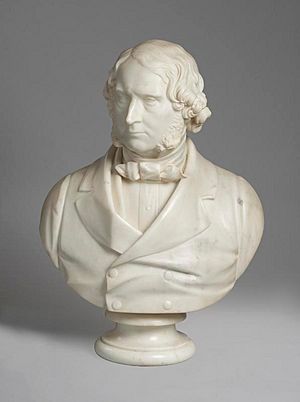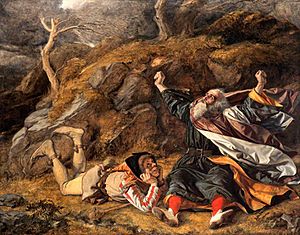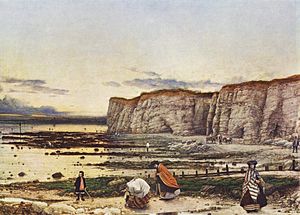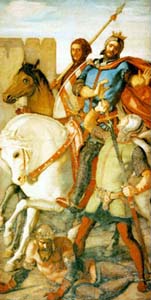William Dyce facts for kids
William Dyce (born September 19, 1806 – died February 14, 1864) was a Scottish painter. He played a big part in setting up public art education in the United Kingdom. He also helped create the South Kensington Schools system. Dyce was linked to the Pre-Raphaelite Brotherhood, a group of artists, and helped them become popular early on.
Contents
Life of William Dyce
William Dyce was born in Aberdeen, Scotland, on September 19, 1806. His father was Dr. William Dyce, and his mother was Margaret Chalmers.
After studying at Marischal College, William showed a talent for art. He began his art training at the Royal Academy schools in Edinburgh and London. In 1825, he traveled to Rome for the first time. There, he studied the works of famous painters like Titian and Poussin.
He returned to Aberdeen after nine months. He painted several pictures, including Bacchus nursed by the Nymphs of Nysa. This painting was shown in 1827. He went back to Rome in 1827 for about a year and a half. During this trip, he met the German painter Friedrich Overbeck, who liked Dyce's Virgin and Child. After these travels, Dyce lived in Edinburgh for several years. He painted portraits to earn money. Soon, he started painting other subjects, especially religious scenes, which he liked best.
Dyce's Role in Art Education
In 1837, Dyce became in charge of the School of Design in Edinburgh. Later, he was asked to move to London. There, he led the new Government School of Design, which later became the Royal College of Art. Before starting this job in 1838, he visited France and Germany. He studied how they taught design there and wrote a report.
He left the school in 1843 to focus more on painting. However, he remained a member of the school's council. Many of his ideas later became part of the "South Kensington system." This system greatly influenced English art education for the rest of the 1800s.
In 1844, Dyce became a professor of fine art at King's College London. He gave an important talk called The Theory of the Fine Arts. He became an associate of the Royal Scottish Academy in 1835. He later became an honorary member when he moved to London. In 1844, he joined the London Royal Academy of Arts, becoming a full member in 1848. Around this time, Dyce moved to Cheyne Walk in Chelsea, London, an area known for artists.
Coin Designs and Music
In 1849, new florin coins were made by the Royal Mint. Dyce designed the back of these coins. It showed crowned shields with symbols of the rose, thistle, and shamrock. He also designed the back of the later Queen Victoria 'gothic head' florins. These coins were made from 1851 to 1887.
Dyce also started the Motett Society (1840–1852). This group worked to bring back old English church music for use in church services. He was known as a skilled organ player.
Dyce passed away in Streatham, Surrey, on February 14, 1864. He is buried in the churchyard of St Leonard’s Church in Streatham. There is also a street in Streatham named after him, William Dyce Mews. A stained glass window in St Machar's Cathedral in Aberdeen also honors him.
Dyce's Art Collections
Dyce's most famous painting today is his very detailed landscape of Pegwell Bay in Kent. This painting is now in the Tate Gallery. It is titled Pegwell Bay, Kent – a Recollection of October 5th 1858. It was shown at the Royal Academy summer exhibition in 1860. The largest collection of Dyce's artwork is kept at Aberdeen Art Gallery in Scotland.
Connection to the Pre-Raphaelites
Dyce is the Scottish artist most connected to the Pre-Raphaelites. He became friends with the young Pre-Raphaelite artists in London. He also showed their work to the important art critic John Ruskin. Dyce's later paintings showed a spiritual style, similar to the Pre-Raphaelites. You can see this in his works like The Man of Sorrows and David in the Wilderness (both from 1860). These paintings show the Pre-Raphaelite focus on small details.
Westminster Frescoes
Later in his career, Dyce started painting frescos. Frescoes are paintings done on wet plaster walls. He was chosen to paint a series of murals at the new Palace of Westminster. To get ready for this big job, he went back to Italy from 1845 to 1847. He wanted to learn more about fresco techniques there. He was very impressed by the frescoes of Pinturicchio and Perugino.
Dyce was asked to decorate the Queen's Robing Room in the Palace. He chose to paint scenes from the Arthurian legends. These are old stories about King Arthur and his knights. It was a bit tricky for him to make these old tales fit the ideas of Victorian times. The Arthurian legend became very popular later on. But when Dyce got the job in 1847, it was not a well-known subject. The stories also had a problem: they included a queen who was unfaithful, which led to a kingdom's downfall. This was a difficult topic for the time.
At first, Dyce tried to tell the story in order on the walls. But he changed his mind and decided to show ideas or virtues instead. In their final form, Dyce's frescoes show scenes from the Arthurian legend that represent different good qualities. These qualities are Mercy, Hospitality, Generosity, Religion, and Courtesy. Two other frescoes, Courage and Fidelity, were planned but never painted.
Dyce was still working on the Westminster frescoes when he became ill. He later passed away at his home in Streatham on February 14, 1864. He was buried at St Leonard's Church, Streatham. A drinking fountain nearby, designed by Dyce in a old-fashioned style, was later dedicated to him by the people of the area.
Family Life
In 1850, William Dyce married Jane Bickerton Brand. She passed away in 1885.
Dyce's nephew, who was his sister's son, was the engineer William Dyce Cay. His niece was the social activist Meredith Jemima Brown.
Gallery of Works
-
Lamentation over the Dead Christ, 1835, Aberdeen Art Gallery
-
St Joseph, 1847, Windsor Castle
-
The Highland Ferryman, 1857, Aberdeen Art Gallery
-
Titian Preparing To Make His First Essay In Colouring, 1856 - 1857, Aberdeen Art Gallery
-
Beatrice, 1859, Aberdeen Art Gallery
See also
 In Spanish: William Dyce para niños
In Spanish: William Dyce para niños












